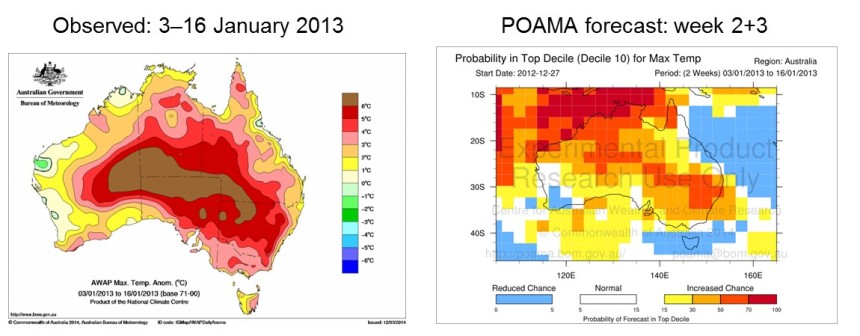Forecasting skills heating up at the Bureau of Meteorology

For Australia, there is increasing demand for forecast information on time scales from a week to a season around extreme events. Results of a recent study led by Debra Hudson of the Bureau of Meteorology show that the Bureau’s seasonal prediction system was able to provide advanced warning for the most extreme heat events occurring during 2013 in Australia.
The paper, recently published in Weather and Forecasting, assessed experimental sub-seasonal forecasts of the three most extreme heat events over Australia in 2013 from the Bureau of Meteorology’s seasonal prediction system, POAMA (Predictive Ocean Atmosphere Model for Australia).
According to the authors of the study “this case study approach forms part of a larger body of work which has investigated the ability of POAMA to provide forecasts of extreme heat on weekly to seasonal timescales.”
The value of this research lies in determining the ability of such systems to enhance current outlooks and seasonal forecasts. The researchers said that “if proven skilful, the outlooks produced can provide significant intelligence and value in addition to the more traditional warnings, weather forecasts, and seasonal outlooks, which constitute the current operational service of the Bureau for extreme weather and climate events.”
The three most extreme heat events over Australia in 2013 occurred in January, March, and September and were associated with severe impacts, including bushfires and significant crop losses. Overall, POAMA provided advanced warning for all three heatwaves. This was particularly the case for the larger spatial scale and longer lived events in January and September.
“The forecasts for the January and September events indicated increased odds of top-decile maximum temperature over most affected areas at least one week in advance for the fortnightly averaged periods at the start of the heat waves, and for forecasts of the months of January and September.”, said Dr Hudson.
The paper focuses on POAMA’s performance for just three heatwave events and as such does not enable one to draw conclusions about the overall skill of the system. The latter has been documented in previous studies using a large set of hindcasts spanning a 30-yr period (Hudson et al. 2011, 2013, 2015; Marshall et al. 2013; White et al. 2013). The case studies provide a valuable complement to these retrospective skill assessments.
Results from this study add to the growing evidence that there is significant potential to extend and augment traditional weather forecast guidance for extreme events to include guidance on longer timescales. According to the authors, it is highly desirable to continue this research and development of heatwave forecasting (and other extremes) with ACCESS-S, the Bureau’s next generation seasonal prediction system. ACCESS-S is currently being developed with the capability for seamless forecasting across the weather-climate interface.
Article: ‘Forewarned is forearmed: Extended range forecast guidance of recent extreme heat events in Australia’, Weather and Forecasting, doi: http://dx.doi.org/10.1175/WAF-D-15-0079.1.
